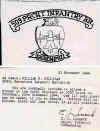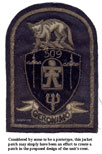|
insigne.org |
The 509 Parachute Infantry Battalion by Les Hughes ©2000 by author |
|
|
|
The unit that would become the 509th Parachute Infantry Battalion (PIB) began its journey to that designation as the 504th Parachute Battalion, the fourth and last independent parachute battalion of the Army’s fledgling airborne forces. When the Army realized the inadequacy of an airborne force of only four battalions, it began forming its parachute units into regiments, and the 504th Battalion became the 2nd Battalion, 503rd Parachute Infantry Regiment (PIR). As the 2/503 PIR, the unit was deployed to England in June 1942, where it underwent further training until November, when it embarked on an airborne operation that would have been ambitious for even a seasoned unit. The unit was to be flown 1,500 miles to North Africa; there to drop at night and conduct attacks on two airfields as part of Operation Torch. The unit was badly scattered, some aircraft ending up in neighboring Spanish Morocco. Eventually, a portion of the unit was able to secure the aerodrome at Tafaraoui. The operation was notable for two reasons: it was the combat debut of America’s airborne forces; and the name of one of the paratroopers who died in the operation, Pvt. J. T. Mackall, would be memorialized in a training center through which most American paratroopers of WWII would pass at one time or another. Two days prior to leaving England for North Africa, the unit had been given the third designation of its brief history: the 2nd Battalion, 509th PIR. In December 1943, the Army dropped all pretense of forming a 509th PIR, and the unit became simply the 509th Parachute Infantry Battalion, the name by which it is known today. From North Africa, the unit would go on to make combat jumps on Sicily, on Avellino, Italy, and on the South of France as part of Operation Dragoon. And it would participate in the amphibious landing at Anzio. From the South of France, the unit was rushed to the Ardennes area to stem the German winter offensive known as the Battle of the Bulge. On 1 March 1945, after having fought from North Africa to Belgium, and having won two Presidential Unit Citations in the process, the 509th PIB was disbanded. The disbandment of the independent battalions was a practical move that had been in the works for some time and did not in any way reflect upon the performance of the units affected. The personnel of the two disbanded independent parachute battalions, the 509th and 551st, were used to bolster the ranks of the airborne divisions in preparation for the final assault of Germany. The 509 PIB is especially well known among collectors of the insignia of airborne units, thanks to its distinctive "Gingerbread Man" jacket patch. This insigne – which depicts a paratrooper standing in the door of an aircraft – was designed, at the request of the unit’s commander, Col. William Yarborough, by Sgt. Henry Pardieck while the unit was based near Piscinola, Italy. The patches were handmade locally as large jacket patches and as smaller patches suitable for wear on a beret. (The 509 had been granted the honor of wearing the maroon beret of the British Parachute Regiment.) Procurement and distribution of the patches was handled by the battalion. One 509 veteran, who bought four, recalls the price being under 25˘ each [1]. Original examples of these patches are illustrated. The evidence indicates that the majority of authentic 509 patches were made at this time. Some were obtained through sources outside the Battalion and account for variations in period examples. The patch on the right in the image above of two bullion examples of the jacket patch was, according to the 509 veteran from whom it came, obtained in Naples. Occasionally examples of the 509 jacket patch surface that are claimed to have been made in France, but I have yet to see that claim documented. The 509 veteran who co-authored a history of the unit told me that some beret patches, employing machine embroidery, were made in France, but I have never seen an example of one [1]. Another insigne unique to the 509 was a tab bearing the word PARACHUTE that was worn above the 5th Army sleeve insigne. The idea of the tab originated with Col. Yarborough, who felt that the word Airborne, by encompassing glider and air-landed troops, did not adequately reflect the special role of paratroopers. It is not clear whether the tab preceded the patch or whether they appeared at the same time. (Doyle and Stewart report both were made at Piscinola [2].) Being designed for wear with the 5th Army sleeve insigne, the colors of the tabs coordinate to that insigne, not to the jacket patch, and are invariably blue or blue and red. Original "Gingerbread Man" patches and PARACHUTE tabs are rare, the tab more so than the patch. (Besides being smaller and more fragile than the patches, many of the tabs were probably removed from uniforms after the 509 left Italy and the 5th Army.) Because of their rarity and their popularity among collectors, reproductions of the patch and tab abound. Three versions of the tab are shown here: the three tabs at the bottom having been made from a single piece of base material and not yet having been cut apart. The first effort to create a patch for the battalion led to one far more ornate than the "Gingerbread Man" patches, and far rarer. The patch in question, effectively a prototype patch, included elements meant to reflect all aspects of the battalion’s history at that time: hyena of the 3d Zouave badge, a trident for the amphibious assaults, and the “Geronimo” of Col. Yarborough’s original unit, the 501st. This prototype version of this patch was deemed too ornate, too “busy,” to be practical, and it was pared down to the simple, yet distinctive, patch design that was finally adopted, a design that lent itself to application, by stencil, to any number of items (e,g., the 509's vehicles and even sign posts, such as the one illustrated above). The ornate design of the prototype patch is similar to one that appears on a number of 509 documents (including the invitation shown in an image here), a design proposed for a 509 crest or distinctive insigne. This design was a favorite of the battalion's S-4, Capt. Edmund Tomasik, who later, as a major, assumed command of the 509 following Col. Yarborough's departure; so the design had a champion within the Battalion [1]. Few of the prototype patches appear to have been made - I know of only about a half-dozen - making an extremely rare. One final insigne that is associated with the 509 is that of the French 3rd Zouave Regiment, which accorded to the 509 the honor of wearing its badge after the two units joined forces for the defense of Youks les Bains. I have had four of these badges - all from 509 vets - and no two were identical. I suspect that, in large part, this is due to many having been made locally. Note: All of the insignia illustrated in this article, except one, were acquired by the author from veterans of the 509. The one exception is the so-called prototype patch, which was acquired by another collector directly from a 509 veteran whom he identified to the author. Footnotes 1. Charles Doyle, private communication. 2. Doyle, C. H. and Stewart, T. Stand In The Door, Williamstown, NJ: Phillips Publications, 1988.
|







